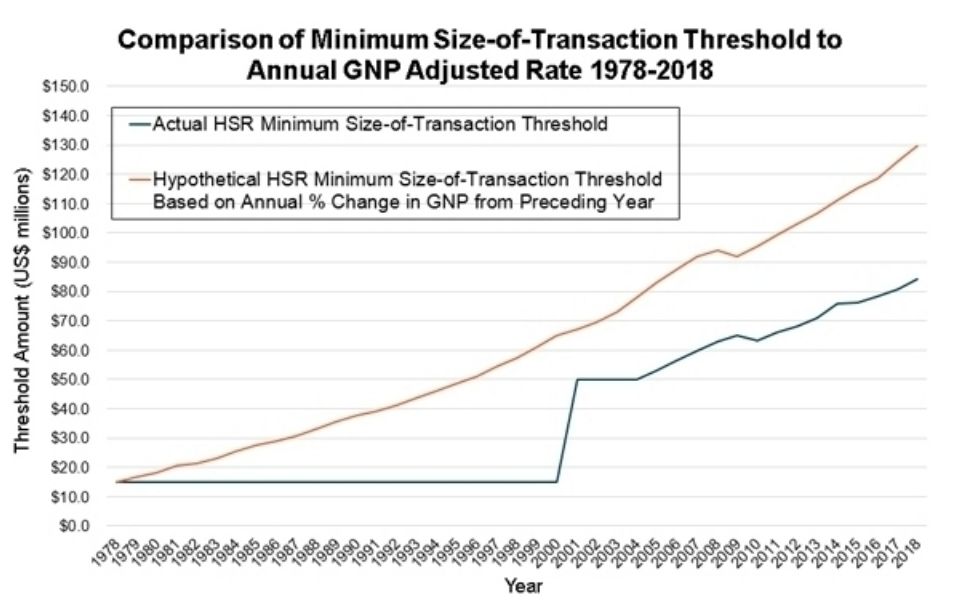HSR Filing Threshold Increases to US$84.4 Million
HSR Act or Rule Provision 2018 / Indexed Value
- US$50 million size-of-transaction test / US$84.4 million
- US$200 million size-of-transaction test / US$337.6 million
- US$100 million size-of-person test / US$168.8 million
- US$10 million size-of-person test / US$16.9 million
- US$50 million notification threshold / US$84.4 million
- US$100 million notification threshold / US$168.8 million
- US$500 million notification threshold / US$843.9 million
- 25% of voting securities valued at US$1 billion notification threshold / US$1,687.8 million
- US$110 million foreign exemption threshold / US$185.7 million
- Filing fees
- US$45,000 for transactions valued at greater than US$84.4 million but less than US$168.8 million
- US$125,000 for transactions valued at US$168.8 million or greater but less than US$843.9 million
- US$280,000 for transactions valued at or in excess of US$843.9 million
The U.S. Federal Trade Commission (“FTC”) announced on January 26, 2018, that the dollar-based thresholds applicable to the Hart-Scott-Rodino (“HSR”) premerger notification program will be raised about 4.4 percent from the 2017 levels. As a result, the HSR minimum size of transaction threshold will be raised to US$84.4 million from US$80.8 million. Transactions valued above the old threshold of US$80.8 million but below the new US$84.4 million threshold will no longer require an HSR filing. The dollar thresholds that determine the applicable filing fee will also be revised accordingly.
The HSR changes will become effective 30 days after publication of the new thresholds in the Federal Register. The new HSR thresholds will apply to transactions that close on or after that date. In previous years, the new HSR thresholds have generally become effective in late February.
HSR Thresholds Raised
As a result of this most recent indexing, the HSR Act now provides that transactions resulting in holdings valued in excess of US$337.6 million among parties engaged in commerce are subject to premerger notification regardless of the size of the parties. Transactions that result in holdings valued in excess of US$84.4 million, but not exceeding US$337.6 million, are reportable only if the acquiring and acquired persons meet the “size-of-person” test — either the acquiring or acquired person must have annual net sales or total assets of US$168.8 million or more and the other party must have annual net sales or total assets of US$16.9 million or more. Acquired persons not engaged in manufacturing must meet the US$16.9 million test on the basis of the value of their assets alone, if their annual net sales are less than US$168.8 million. (Of course, certain transactions meeting these size thresholds may nevertheless be exempt under the HSR Act.)
The maximum civil penalties for violations of the HSR Act are similarly indexed, and have increased from US$40,654 per day to US$41,484 per day, effective as of January 22, 2018, the date of publication in the Federal Register.
The HSR premerger notification program applies to large transactions involving large parties engaged in commerce. Dollar thresholds defining “large” were increased in 2000 from US$15 million to US$50 million and, since 2005, have been indexed to reflect changes in the gross national product (GNP). The following graph illustrates the changes in the HSR minimum size-of-transaction thresholds, as compared to changes in the GNP since 1978, when regulations implementing the HSR Act first went into effect. If the US$15 million minimum size-of-transaction threshold in 1978 had been indexed to changes in the GNP, it would be at approximately US$129.5 million rather than US$84.4 million.

Revised Rules for Interlocking Directorates
Section 8 of the Clayton Act generally prohibits a person from serving simultaneously as a director or officer of two sizable competing corporations engaged in commerce, unless their “competitive sales” — the gross revenues for all products and services sold by one corporation in competition with the other — are minimal. As with the HSR Act, the dollar thresholds defining “sizable” and “minimal” are indexed to changes in the gross national product. As a result of the most recent indexing, the Section 8 prohibition on interlocking directorates now applies only if each competing corporation has capital, surplus, and undivided profits aggregating more than US$34.395 million. The interlocking directorate prohibition does not apply, however, if either corporation’s “competitive sales” are less than US$3.4395 million. Other “safe harbors” exist that are based on calculating the competitive sales as a percentage of the corporation's total sales.
Provision under Section 8 of the Clayton Act / 2018 Indexed Value
- Capital, surplus and undivided profits aggregating more than US$10,000,000, under Section 8(a)(1) / US$34,395,000
- Competitive sales of either corporation are less than US$1,000,000 under Section 8(a)(2)(A) / US$3,439,500
The FTC’s press release announcing the indexing changes to the HSR thresholds and the interlocking directorates thresholds may be accessed by clicking on the link below. The press release contains links to the FTC’s official announcements.



